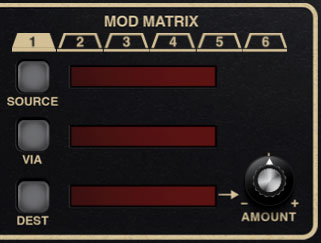
Pro Soloist's modulation routings are extensive and super easy to use. Each of its six mod slots have source, via, and destination popup menus and a bipolar attenuator to adjust the amount of mod.
Mod Slot Select tabs 1-6 - To configure a mod routing choose which slot you'd like to use by clicking on one of the numbered tab.
The tab colors change to indicate their status as follows:

Pro Soloist includes six mod slots, each with identical controls that make use of a tabbed user interface. The tab background coloring works as follows:
The currently selected mod slot tab will be gold. The controls will affect that mod slot only.
If a mod slot is not currently selected and does not have a destination set up, the tab background will be black.
If the mod slot currently has a destination setting, but it isn't selected, the tab background will be white. This makes it easy to see which mod slots have routings configured without having to individually click each tab.
Source button and display- Clicking on the display screen opens a popup menu that selects the modulation source. Modulation sources are divided into type submenus.
Via button and display- The Via button allows a mod source to dynamically control how much modulation is occurring. When using a Via mod source, the Amount attenuverter sets the maximum mod amount. Via is often used to set up mod wheel-controlled vibrato.
Amount attenuverter knob- Sets the amount of mod applied to the parameter for the currently chosen mod routing. The Amount knob is bipolar, so center position is off; turning the knob to the right applies positive modulation, and turning to the left applies negative modulation.
Modulation from two or more sources can be routed to the same parameter by combining multiple Mod Matrix slots (or multiple mod sources can be combined from the Mod Matrix and the dedicated oscillator Center and Width mod boxes). All modulation is additively summed.
Destination (Dest) button and display- The Dest button opens a popup menu that selects the modulation destination, i.e. what's getting modulated. Modulation destinations are divided into type submenus.
Mod and Via Sources
|
MOD SOURCES/VIA CATEGORY |
MOD SOURCE |
|---|---|
|
LFOs |
LFO |
|
LFOs |
GROWL |
|
LFOs |
PHASER LFO |
|
LFOs |
FLANGER/CHORUS LFO |
|
ENVELOPES |
ADSR ENVELOPE |
|
ENVELOPES |
AR ENVELOPE |
|
OSCILLATOR |
SAWTOOTH WAVE |
|
OSCILLATOR |
PULSE WAVE |
|
OSCILLATOR |
RESONATOR MIX |
|
OSCILLATOR |
VCF MIX |
|
KEYBOARD |
MOD WHEEL |
|
KEYBOARD |
PITCH BEND |
|
KEYBOARD |
KEYBOARD CV |
|
KEYBOARD |
VELOCITY |
|
KEYBOARD |
CHANNEL PRESSURE |
|
KEYBOARD |
POLY AFTERTOUCH |
|
KEYBOARD |
ARPEGGIATOR CV |
|
SIGNALS |
WHITE NOISE |
|
SIGNALS |
PINK NOISE |
|
SIGNALS |
MONO RANDOM DC |
|
SIGNALS |
POLY RANDOM DC |
|
SIGNALS |
+10V DC |
Mod Destinations
|
DESTINATION CATEGORY |
DESTINATION |
|---|---|
|
LFO |
SPEED |
|
LFO |
DELAY |
|
VCO |
FREQUENCY |
|
VCO |
PULSE WIDTH |
|
VCO |
SAW LEVEL |
|
VCO |
PULSE LEVEL |
|
VCO |
HIGHPASS FREQUENCY |
|
VCO |
RESONATOR MIX |
|
RESONATORS 1/2/3/4/5 |
FREQUENCY |
|
RESONATORS 1/2/3/4/5 |
RESONANCE |
|
RESONATORS 1/2/3/4/5 |
VCF AMOUNT |
|
RESONATORS 1/2/3/4/5 |
VCA AMOUNT |
|
VCF |
CUTOFF |
|
VCF |
RESONANCE |
|
VCA |
VOLUME |
|
VCA |
PAN |
|
ADSR |
ATTACK |
|
ADSR |
DECAY |
|
ADSR |
SUSTAIN |
|
ADSR |
RELEASE |
|
AR |
ATTACK |
|
AR |
RELEASE |
|
DISTORT |
DRIVE |
|
DISTORT |
TONE |
|
DISTORT |
LEVEL |
|
PHASER |
FREQUENCY |
|
PHASER |
DEPTH |
|
PHASER |
RESONANCE |
|
FLANGER/CHORUS |
FREQUENCY |
|
FLANGER/CHORUS |
DEPTH |
|
FLANGER/CHORUS |
FLANGER DELAY |
|
FLANGER/CHORUS |
FLANGER RESONANCE |
|
FLANGER/CHORUS |
MIX |
|
ECHO |
TIME |
|
ECHO |
FEEDBACK |
|
ECHO |
DAMPING |
|
ECHO |
SPREAD |
|
ECHO |
MIX |
|
REVERB |
DECAY |
|
REVERB |
HIGHPASS |
|
REVERB |
LOWPASS |
|
REVERB |
MIX |